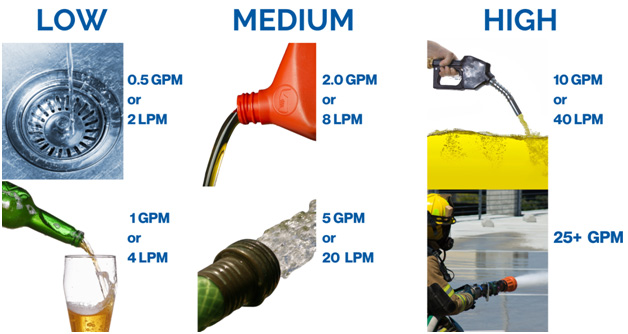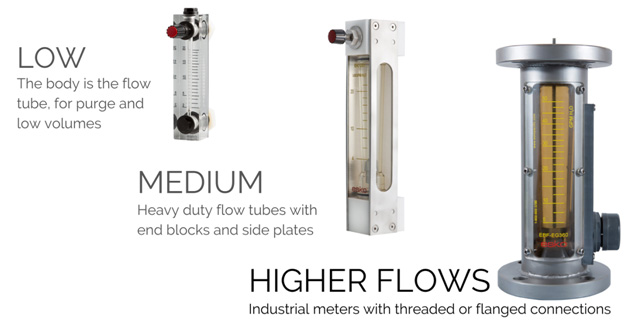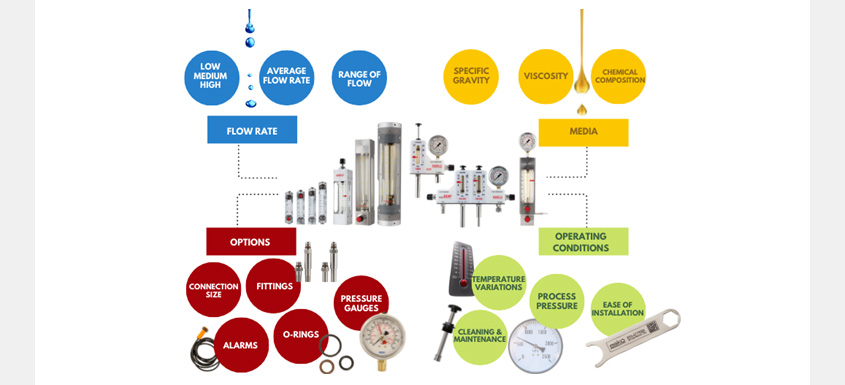Flow meters are highly customizable due to differences in design, function, accuracy, and build components such as tube materials, end block materials, fittings, floats, valves, o-rings, flow configurations and more.
Identifying and customizing metering products for specific aspects of an application can help ensure that efficiency and cost objectives are met to:
- Avoid overspending where a cost-effective alternative exists but,
- Budget appropriately where durable components and a high degree of accuracy are critical to the process.
This methodology focuses on finding solutions for flow measurement of liquids and gases with time tested variable area meters in the following steps:
STEP 1: Define the Objective - Confirming the key objectives for the application will help define appropriate materials and customization options.
- Required degree of accuracy - establish this first. In some applications it is helpful to simply assess by glancing at the flow meter the presence or absence of flow. In other applications, however, it is critical to know precisely how much flow there is or should be, or to install equipment to maintain the desired flow range for the process.
- Alarm options - do operators need to know if there are flow variations or absence of flow? An alarm (float proximity sensor) can alert operators to unexpected high or low flows.
- Trending - would collecting trend information be useful for process management?
- Regulating flow - Is maintaining a constant flow optimal for the process or equipment health?
STEP 2: Understand the Media - Answer these questions about the media (all substances that could be passing through the meter).
- Chemical Composition of the media - considering variables like mixing of ingredients, potential for mixing due to process variations, and particulates or contaminants that may be present. This is important as the media or any component ingredients may react chemically with meter components, causing degradation, inaccurate readings, or unexpected failures.
- Viscosity of the media - are there variations in viscosity? For example, circulating oil viscosity at machine start-up vs. at operating temperature will vary; the right meter can provide an accurate reading under various operating conditions.
- Specific Gravity - the ratio of the media’s density to that of a standard media (usually compared to water at 4°C for liquids, or to dry air for gases).
- Temperature - the range of temperature variations of the media under all operating conditions as well as the ambient temperature where the meter is located.
- Pressure of the media/flow - does pressure vary or remain constant? Is there backpressure?
- Other special conditions? What are the ambient operating conditions? What conditions and media are the outside of the meter exposed to? Are adjustments to flow required? Hand knob or screwdriver flow control valves are available on most meters. Is a tamper-proof flow control valve required?
STEP 3: Determine the Flow Rate - Both the average flow and range of flow in the application are needed as the flow meter will need to indicate normal flow variations and be able to withstand all process variations. This information will define the scale range required. For liquids and gases other than water or air under standard conditions, custom calibration may be required. A calibrated direct reading scale allows for readings at defined process conditions.
Water, oil and other liquids are usually expressed in:
GPM = GALLONS per minute or LPM = LITERS per minute.
Air and gases are usually expressed in:
SCFM* = Standard cubic feet per minute or NLPM = Normal liters per minute.
*standard pressure and temperature defined as 68° F at sea level
To estimate liquid flows, handy references are:

STEP 4 - Installation Logistics - Aim for smooth installation and easy ongoing maintenance by determining installation logistics up front.
- Connecting to the process - how will the meter connect to the process? The material and type of connection must be able to withstand parameters identified in Steps 2 & 3. Does the installed meter require supportive mounting? What size and type of connections/fittings/adapters are needed? Are there multiple connected flows? Is remote monitoring required?
- Valve configuration - Is a flow control valve required? What is the flow direction? Is a valve required on the inlet or on the outlet?
- How “RUGGED” is required? - Will standard adapters and materials do the job, or are heavy duty material components needed?
- Other Operating Challenges - Will the installed meter be visible to operators? Is a clear visible scale required? Will the flow be monitored remotely? Sensors can connect to control systems. Is there access to the meter for cleaning and maintenance?
STEP 5 - Choose the Right Meter - Collecting all the relevant information in this step-by-step analysis will provide operators the information needed to efficiently target the optimal meter type and design, material specifications, options and add-ons that best suit the application.
At ESKO Pacific, we’ve been working with paper mills for almost 40 years supplying variable area flow meters constructed from high quality components. Contact us today to see how we can help keep your mill running smoothly with tried-and-true technology.
See our complete line of metering solutions at www.eskopacific.com
We encourage you to ‘ASK US HOW’

Visit us online at www.eskopacific.com.
Source: ESKO Pacific













